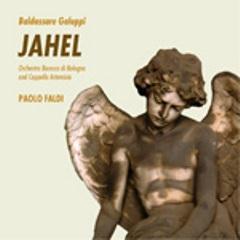Baldassare Galuppi – Jahel (Oratorio) [2013]
Baldassare Galuppi – Jahel (Oratorio) [2013]

1. Part 1 1:03:40 2. Part 2 1:05:45 Pamela Lucciarini, soprano (Jahel), Silvia Vajente, soprano (Debbora), Elena Biscuola, alto (Barac), Candace Smith, alto (Sisara), Patrizia Vaccari, soprano (Nabal), Laura Antonaz, soprano (Haber) Orchestra Barocca di Bologna and Cappella Artemisia Dir. : Paolo Faldi Regensburg, Ancient Music Festival, May 19, 2013
Dr. Charles Burney, who in August 1770 heard Galuppi’s singing girls at the Incurabili, one of Venice’s four competing Ospedali or musical orphanages, admired both their excellent performing standard (“indeed all were such as would have merited and received great applause in the first operas of Europe”), and the quality of the music that the aging maestro was still able to write for them: “ it is generally allowed here that his last operas, and his last compositions for the church, abound with more spirit, taste, and fancy, than those of any other period of his life”.
Had Burney visited Venice and the Incurabili short earlier, on May 24, he might have attended the premiere of Jahel, a Galuppi oratorio recently unearthed at the Zurich Central Library in Switzerland — probably a remake of the score already performed at the Ospedale dei Mendicanti in 1747 and 1748. By 18th-century standards, 23 years was quite a long time-span in the change of musical taste. Perhaps that’s why in 1772 Galuppi reverted to the same subject on a different libretto and with a larger cast of characters under the title Debbora prophetissa, but the core story remained the same, based on chapters 4-5 of Judges in the version provided by the Latin Vulgate Bible.
Actually, despite the triumphs gathered by his operas in London, Saint Petersburg and Vienna, nowhere did Galuppi enjoy more popular acclaim than as a composer of Latin oratorios on Bible subjects for the Ospedali of his native Venice. It is reported that his Tres pueri hebraei in captivitate Babylonis — premiered in 1744 at the Mendicanti — scored some hundred (paying) performances, a feat comparable to those of modern musical theater. Unfortunately, the 1770 version of Jahel is all we are left with in this genre, since two more oratorios surviving in musical sources (Adamo caduto of 1747) and Il sacrificio di Jephtha of 1749) are in Italian.
At the outset of the eighteenth century, the language of oratorios at the Incurabili became exclusively Latin, to remain so under the musical directorship of Porpora, Jommelli, Cocchi, Ciampi, and Baldassare Galuppi. A similar trend affected more or less the remaining three Ospedali. Although the librettists’ choice was for a simplified variety of Latin, aping at the stock imagery from contemporary cantata and opera seria texts, one wonders whether the traditional status of Venice as a target for multinational operagoers could account for such an unexpected association between Latin and bel canto on a scale even larger than in Catholic church-service proper.
Hearing those notes again within the Scuola Grande di San Rocco — the ‘Sistine Chapel of Venice’ studded with masterpieces by Tintoretto, Titian and Tiepolo — was well worth a trip. As to the actual merit of the performance, one might regret that a few arias were pruned of their da capo, or that a harpsichord was substituted to the organ stipulated in the continuo section. Nevertheless, the sparse period band Orchestra Barocca di Bologna, some ten instrumentalists led by Paolo Faldi, sounded well attuned to style requirements, with rhythmic stamina and accurate tuning generally deserving appreciation throughout.
Not all the six singing ladies would have deserved the same applause as their early counterparts, either out of lacking experience or worn-out voices (the latter was probably the case for Candace Smith in the role of Sisara). Yet both sopranos Pamela Lucciarini in the title role and Silvia Vajente (Debbora) delivered terrific amounts of passagework, competing on a tight edge as to projection and clarion notes. In the end, Vajente apparently won by a neck thanks to a clearer diction and to the sensuous rendering of her aria “Rosa et lilio”, accompanied by a pair of obbligato mandolins. As Barac, mezzo Elena Biscuola unsheathed lovely dark color, accomplished technique and dramatic panache. Her climactic duet with Vajente (“Fugato jam maerore”, just before the final ensemble) was also praiseworthy.
Patrizia Vaccari, a coloratura soprano of considerable experience, delivered a defiant rendering of “Non horret cor forte”, much in the vein of Constanze’s “Martern aller Arten”. The taxing ‘storm’ aria for Haber, “Pugnent nubes fulminando”, emphasized the good natural qualities of young soprano Laura Antonaz, such as sterling color and easiness in ascending to the highest pitches. Her coloratura technique needs further refinement, though. ---Carlo Vitali, www.operatoday.com
download (mp3 @128 kbs):
yandex 4shared mega mediafire cloudmailru uplea ge.tt








